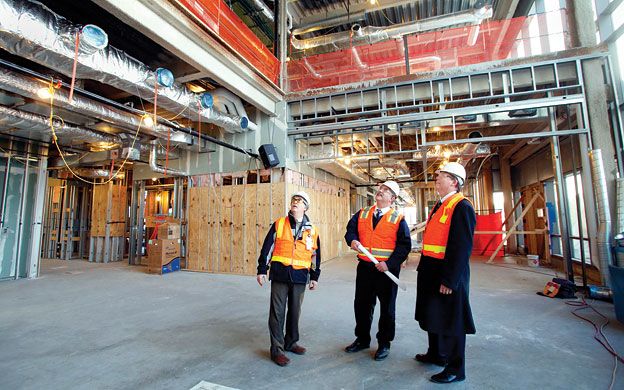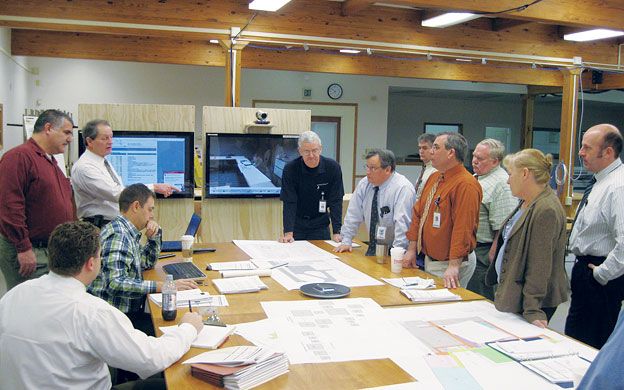A collaborative construction process produces the new MaineGeneral
When Augusta's new MaineGeneral hospital opens in the fall of 2013, the $312 million project will showcase not only the latest medical diagnostic and treatment services, but also a new trend in construction management expected to benefit the hospital and the companies involved in its creation.
Integrated Project Delivery is a collaborative form of construction management requiring all project stakeholders to contractually agree to share in the risks and rewards associated with a large-scale construction project.
The process differs from more traditional construction methods by encouraging project owners, design professionals and builders to work together throughout the project instead of handing off responsibility once their part of the work is done. Whereas an architect typically designs a project and then hands the blueprints to a contractor to execute them, IPD requires the architect, contractor and project owner to work in concert throughout the process.
The upside is maximized efficiency and reduced waste and the opportunity to harness the talents and insights of individuals who might not normally get to see a job through to its completion, according to Chuck Hays, president & CEO of MaineGeneral Medical Center at MaineGeneral Health.
“While IPD is still in its infancy, it has really shown a lot of promise from both a schedule and cost perspective while still maintaining quality,” says Hays. “By having all contractors in on the design process, they can immediately tell you a better or cheaper way to do something. It's also more efficient from a labor standpoint.”
Hays credits the approach with putting the hospital project “a couple million dollars” under budget and seven months ahead of schedule.
Mammoth project
When completed, the 640,000-square-foot, four-story hospital will house 192 private patient rooms, a helipad, a streamlined emergency department, 10 operating rooms, a medical library and meeting space for up to 300 people.
At $312 million, the new MaineGeneral campus is the largest construction project in the state. At the height of construction last summer, 400 to 500 workers — 92% from Maine — worked to mold 4,500 tons of steel and 1,900 truckloads of concrete into a cutting-edge medical facility for the Kennebec Valley region.
While particularly suited for complex, large-scale projects like medical and science facilities, IPD was not really on Hays' radar until discussions about a new hospital were under way.
“As we were looking at the design of the new hospital, we asked all of our administrative managers to go look at evidence-based design, where it's been proven that the design of a hospital can increase safety or quality,” says Hays. He cites, for example, how the use of a handrail between a patient's bed and bathroom can help reduce slips and falls by 10%. “When we were thinking about how to manage the project, we decided to take the same approach and ask, 'What are all the ways you can run a project, and what is the best method?'”
Having used similar collaborative methods in the construction of the Harold Alfond Center for Cancer Care, which opened in 2007, the MaineGeneral team was open to the IPD concept, according to Rick Albert, the hospital's director of plant operations and engineering and a member of the project management team.
“This seemed like an obvious next step, especially for a project of this size,” says Albert.
The IPD method requires players to pool their risk, giving subcontractors a tangible stake in the success of the project and helping to combat the sort of passing of the buck that can occur on such large-scale contracts.
“All the major contractors who are part of the IPD contract have all of their profit at risk,” says Hays. “If a project comes in on budget, they get the budgeted amount; if it's under budget, they split the difference and 50% goes into their profit pool. If it's over budget, it comes 100% out of their profits.”
“The fact that you can go into a room and everyone owns it is very unique. Usually there is [conflict] between contractors, but we don't have that here because everybody is focused on the solution,” says Albert. “Everyone shares in the wins and everyone shares in the losses.”
The approach did raise some issues over liability. MaineGeneral struggled to find an insurance company with experience in crafting the sort of shared-responsibility package it wanted.
“The insurance companies were not prepared for a contract that holds everyone responsible,” says Albert, who says the biggest issue was the question of “if we run into a problem but there were two [subcontractors] working in that area, who is responsible?”
What is IPD?
The first definition of IPD was established in 2007 by the American Institute of Architects' California Council. Partially cribbed from the lean production methods at the center of the Toyota Motor Corp.'s Toyota Production System, the focus of IPD is to maximize the final value created for the owner by encouraging collaboration between players, and asking them to consider the broader implications of their own work on the process as a whole.
This focus on cooperation eliminates waste in the design of a project, and allows data sharing between the design and construction companies, according to Brian Turmail, spokesman with The Associated General Contractors of America.
“It's a growing trend, but at this point it's only seen on very large and complex projects [like] health care construction” says Turmail.
Central to the success of an IPD project is its team. Albert says assembling a team willing to explore a new and somewhat risky method of construction management was the important aspect of using IPD in the Maine project.
“The biggest part was getting everybody involved early on. As we were interviewing subcontractors, it was evident that the dynamics of the contract were as important as their ability to do the job,” he says. “If they came in to do an interview and the sense was 'I don't know if these guys are going to play well,' that came into the discussion.”
In the end, the hospital chose Portland architecture firm SMRT to design the new facility, with Winthrop's H.P. Cummings and Birmingham, Ala.-based Robins & Morton forming a joint venture to land the contracting work.
“This has been a great learning experience for us for several reasons,” says John Scott, vice president of H.P. Cummings. “We tend to collaborate heavily anyway, but the IPD format really raised that to a new level,” he says.
Founded in 1879, H.P. Cummings' early niche was building paper mills and dams across the state. When that work dried up in the '30s, the company expanded into health care and higher-end construction projects, which Scott says “require a higher level of technical expertise.”
“IPD has helped us to understand the design process better, [like] how the workflow goes with the architects and engineers, and being involved in the user group meetings gave us a lot of insight as to what the end users need on a project like this,” says Scott.
In the short term, the MaineGeneral project allowed H.P. Cummings to flourish during a tough time in the building industry.
“Without question, the timing of this project helped us as well as the whole subcontractor community. Volume was way down when the project went on the street, and this allowed us to weather some of the worst times the construction industry has seen in a while,” says Scott.
The MaineGeneral contract also came at an important time for SMRT, says President Ellen Belknap.
“Our heaviest year from a design standpoint was 2011, and this job represented over 50% of our revenue for that year,” says Belknap. “In 2010 and 2011, the industry was really in a trough; the fact that this allowed us to grow in the recession was not insignificant.”
Other benefits
The collaborative approach to project management extends beyond the design and construction phases.
By emphasizing communication and minimizing conflicts between contractors, the IPD system allowed the team to be very nimble in its approach to purchasing. For example, SMRT principal Craig Piper says thanks to IPD, MaineGeneral will be able to purchase the most up-to-date equipment without worrying whether it will fit through a door that was designed months earlier.
“This gave them the flexibility to wait to the absolute last moment to purchase so they have the best bells and whistles,” he says.
The chance to buy materials in advance was another advantage, according to Albert.
“Some of the subcontractors had the opportunity to procure materials in advance when the pricing was good, and we worked with them to be able to procure them if they didn't have the funds. We expended dollars early, but in the long-term it saved [money for] the project,” says Albert.
The transparency offered by IPD was another source of savings.
“All the costs down to the last man are transparent to us,” says Albert. For example, “right now we are looking at how the manning curve will start to go down during the project, which during a normal job we might not be privy to,” allowing the hospital to keep close tabs on the work force and raise concerns if it feels the current phase of the project is overstaffed.
Specialized purpose
Whether IPD will continue to gain a toehold in construction is unknown. The method is particularly popular in California, where legislation requires retrofitting 2,700 buildings at 270 hospitals by the end of this year to enhance their protection from earthquakes. Without a critical mass of highly complex projects, IPD might not make sense.
“The question is, is it a trend that is going to become standard practice within 10 years? I don't think people see it headed that way, but its use will increase, especially on large projects,” says AGC's Turmail.
“In a hospital you've got so many different wires, piping, and purpose-specific rooms like X-ray labs that all have different needs. You get a level of complexity where it is a lot harder to get everything right than at an office building, where there is just HVAC and [electricity],” he says.
Luckily for IPD advocates, there are growing markets for complex building projects.
“You see this used in higher education construction like science labs and high-tech facilities on campus,” says Turmail. “We are actually in the process of [researching] what our members expect the market to look like in 2013, and 'eds and meds' look like the most promising.”
IPD has been used in the Pentagon's long-running renovation and construction effort. As the world's largest low-rise office facility and a nexus of communication, the Pentagon contains over 1,700 miles of cabling, more than 100,000 voice, data, and video drops, and 16 server rooms across 6.5 million square feet.
While IPD has its advantages on a large scale project like MaineGeneral, it might not be for everyone.
“It's a lot of investment in upfront time, but it saves time on the back end, so obviously for smaller projects it's not worth that time, but on medium to large projects, it would work well,” says Hays.
Turmail says IPD is just a way of codifying a new level of collaboration that has risen organically within the industry as of late. Even projects not expressly using IPD have seen aspects of the method slip into conventional processes, with what Turmail calls “IPD light.”
“In IPD light, they don't have the same contract structure, but you see a lot of the same processes applied,” says Turmail.
If nothing else, IPD brings about some situations that are rare in the construction industry.
“It's unique to sit in a room with a bunch of contractors and nobody is pointing any fingers,” says Albert.

















Comments